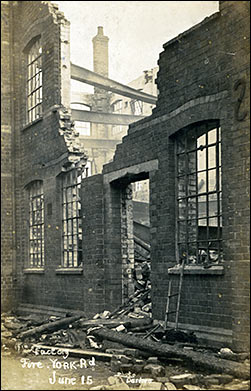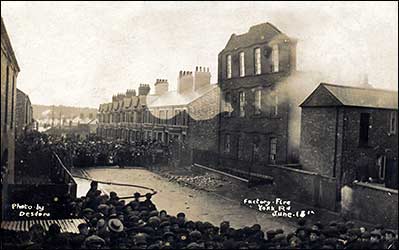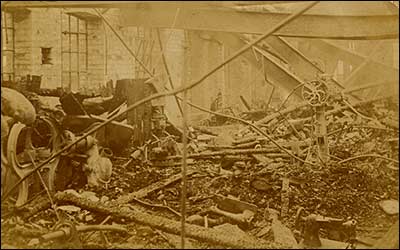|
Large Factory Gutted
 |
|
This photograph of the aftermath of the fire
was made into a postcard
|
|
A disastrous fire broke out on Saturday afternoon at the spacious factory of Messrs Ellard and Howes, boot and shoe manufacturers, York-road, Rushden, the premises being entirely gutted in a short space of time. The factory, a three-storey building of brick and tile, with iron girders, had a base measurement of 30 feet by 81 feet. It was built about ten years ago by Mr Ebenezer Wrighton. Messrs Ellard and Howes, formerly of John-street, Rushden, have rented the premises for the last eighteen months, and they employed about 100 hands, who have been temporarily thrown out of work.
How the fire occurred
Mr Arthur Ellard (son of Mr John Ellard, the senior partner in the firm) is in the habit of going back to the factory on Saturday afternoons to look after the books. Last Saturday afternoon he returned about 2.30 or 2.45. Messrs Ellard and Howes use a certain preparation in the manufacture of boots in order to make them waterproof, and he placed some of this preparation on a stove in the finishing room on the middle floor. During a brief absence in the next room the pot boiled over, and the preparation caught fire. As soon as Mr Ellard discovered what had happened he rushed to the pot and caught hold of it by the handle, severely burning his hands. Finding he could not cope with the flames he gave the alarm by telephone, and rushed out of the factory to inform the neighbours.
Firemen’s prompt response
Within a few minutes of giving the alarm, G R Turner (the secretary of the Rushden Fire Brigade), together with Sub-Engineer Claude Green, Firemen Nuttall, J Sparrow, and J Whiting were at the scene of the fire with the hose cart and ladder truck, and they set to work with desperate energy to fight the flames. The remainder of the brigade, Second Officer John Thomas Colson, Firemen F Underwood, Mark Wildman, and R Twelvetree speedily followed. Captain Fred Knight, JP, was at Higham Ferrers at the time. He was telephoned for, and luckily he managed to catch the 3.45 train from Higham Ferrers to Rushden. There was not a single delay as far as the brigade was concerned. They first got a hydrant to work in Grove-street, and entered the building by the side door, and tried to get to the body of the fire, but the smoke was so dense and the heat so intense that they were driven out. They then got to work at the other side of the factory. Another hydrant was utilised, but the pressure was not at all satisfactory until the water was turned off at Higham Ferrers.
Rapid spread of the flames
When the alarm was first given, there were only about half-a-dozen spectators present, and they describe the outbreak as phenomenal in its suddenness. At first they noticed a thin sort of haze envelop the building. Then suddenly flames shot out of the windows like rockets. In a few minutes the whole of the north end of the factory where the outbreak originated was a seething mass of fire. The Brigade soon realised the hopelessness of their task. In half-an-hour’s time the roof at the north end of the factory fell in with a crash, and the flames spread to the remainder of the building. Fortunately the factory is isolated, narrow passages dividing it from the surrounding buildings, and this fact undoubtedly prevented the conflagration from spreading beyond the confines of the one building. As it was, however, there was at one time a serious danger of some adjoining stables and a store-house being involved. They belong to Mr Britten, and in a loft of one of the buildings a quantity of hay and straw had recently been stored. The buildings lay directly in the teeth of the wind, which was blowing in a south-westerly direction, and the roof caught. The firemen at once turned the water on the building. Their prompt action was successful, and the building was saved. Water was poured on the adjacent buildings, which were also saved from ignition. The firemen worked heroically under most trying conditions. Driven back time after time by dense volumes of smoke, half suffocated with masonry falling at every minute, they returned to the work, and at last had the satisfaction of knowing that the damage would be confined to the one building.
 |
 |
|
Postcard by William Desborough
|
Inside after the fire
|
A heap of ruins
In a remarkably short time the fire had burnt itself out, and nothing remained but the skeleton of the walls, and a smoking mass of debris. A more utter ruin could not be imagined.
The factory was divided into five rooms, the clicking, finishing, lasting, rough stuff, and shoe rooms, which were divided by wooden partitions. Wood entered largely into the internal construction of the building, which accounted for the rapidity and fury of the conflagration. It was equipped with a full plant of modern machinery—lasting, sewing, stitching, heel, finishing, and closing machinery. Most of the heavy machinery, including the gas engine, was on the ground floor, but the finishing machinery, about 10 or 12 cwt, was on the second floor, and the closing machinery, which is very light, was on the top floor. All of it was strewn in a state of chaos on the ground amidst a mass of charred wood. Much of the machinery was unrecognisable, but here and there the operatives were able to identify in twisted, bent, and broken fragments of iron what had formerly been their machines. In several cases the girls’ machines had been snapped in half.
A curious spectacle was provided by a heel-scourer which had been caught in falling through the floor on a shaft and hung in mid-air. The boots and leather had been utterly consumed. In the evening the safe was recovered, much battered and with a hole in it, through which the fire had penetrated. The books were whole, although much blackened. There was very little money in the safe, Mr Ellard having, in accordance with the usual practice, taken most of the cash to the bank in the morning.
The Police
The firemen have a special word of praise for the able manner in which the police controlled the crowd. Inspector Cameron, Sergeant Judge, and a posse of police were present during the whole of the time. The inhabitants of the neighbouring houses were at first in a state of panic, and began to move their goods and chattels, but they were soon re‑assured by the prompt measure of the Fire Brigade. As soon as the fire had subsided the firemen proceeded to secure the remainder of the building. The walls in several places were in a tottering condition, the front leaned forward in a threatening manner, and of the three iron girders two were sagging down in a dangerous way. The loose portions were knocked down with long poles, and one fireman bravely ascended a ladder placed against the front wall and removed the bricks at the top which threatened to topple over into the street.
Until late in the evening flames broke out spasmodically among the ruins, and in the woodwork in the walls, but there were plenty of willing helpers and the fire was speedily extinguished.
The firemen
The bulk of the brigade left the scene of the fire at about 8.30pm, leaving Secretary Turner, Sub-engineer Claude Green, Private J Sparrow and Private J Whiting in charge. Mr Turner left about half-an-hour after midnight, and the others remained until 5.30 on Sunday morning.
The dangerous walls were pulled down on Saturday evening by Privates Whiting, Underwood, and Sparrow, without personal injury.
On Sunday night Capt Knight, and Messrs Turner, Green, and Nuttall got to work again, as the debris was bursting out into flame, and they remained on duty about an hour.
The damage is roughly estimated at about £6,000. About £2,000 represents the value of the building, which was fully insured in the Phoenix, and the remainder is the worth of the stock, machinery, &c, this being insured in the Scottish Union.
|